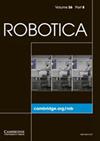基于 3RRUR 并联机械手的矢量推进器运动学分析和先进控制,用于微型自动潜航器
IF 2.7
4区 计算机科学
Q3 ROBOTICS
引用次数: 0
摘要
自主潜水器(AUV)在推动海洋勘探和开发方面发挥了关键作用。然而,传统的自动潜航器在以最小或近乎零的前进速度执行任务时,由于其控制面效果不佳而受到限制,从而大大制约了其潜在的应用领域。为了应对这一挑战,本文介绍了一种创新的矢量推进器系统,该系统基于专为微型 AUV 量身定制的 3RRUR 并行操纵器。当微型自动潜航器以最小和较低的前进速度运行时,矢量推进器的加入增强了其性能。通过理论分析和实验验证,对推力矢量机构的运动学进行了全面探索。理论分析和实验验证的结果明确肯定了所设计的推力矢量机构的可行性。利用物理信息神经网络和模型预测控制(PINN-MPC)对矢量装置的精确控制进行了研究。通过采用这种植根于 3RRUR 并行机械手的开创性推力矢量机制,AUV 可以高效率、高效益地产生推力矢量推进所需的运动,从而克服传统 AUV 的局限性,拓展其在各个领域的潜在应用。本文章由计算机程序翻译,如有差异,请以英文原文为准。
Kinematic analysis and advanced control of a vectored thruster based on 3RRUR parallel manipulator for micro-size AUVs
Autonomous underwater vehicles (AUVs) have played a pivotal role in advancing ocean exploration and exploitation. However, traditional AUVs face limitations when executing missions at minimal or near-zero forward velocities due to the ineffectiveness of their control surfaces, considerably constraining their potential applications. To address this challenge, this paper introduces an innovative vectored thruster system based on a 3RRUR parallel manipulator tailored for micro-sized AUVs. The incorporation of a vectored thruster enhances the performance of micro-sized AUVs when operating at minimal and low forward speeds. A comprehensive exploration of the kinematics of the thrust-vectoring mechanism has been undertaken through theoretical analysis and experimental validation. The findings from theoretical analysis and experimental confirmation unequivocally affirm the feasibility of the devised thrust-vectoring mechanism. The precise control of the vector device is studied using Physics-informed Neural Network and Model Predictive Control (PINN-MPC). Through the adoption of this pioneering thrust-vectoring mechanism rooted in the 3RRUR parallel manipulator, AUVs can efficiently and effectively generate the requisite motion for thrust-vectoring propulsion, overcoming the limitations of traditional AUVs and expanding their potential applications across various domains.
求助全文
通过发布文献求助,成功后即可免费获取论文全文。
去求助
来源期刊

Robotica
工程技术-机器人学
CiteScore
4.50
自引率
22.20%
发文量
181
审稿时长
9.9 months
期刊介绍:
Robotica is a forum for the multidisciplinary subject of robotics and encourages developments, applications and research in this important field of automation and robotics with regard to industry, health, education and economic and social aspects of relevance. Coverage includes activities in hostile environments, applications in the service and manufacturing industries, biological robotics, dynamics and kinematics involved in robot design and uses, on-line robots, robot task planning, rehabilitation robotics, sensory perception, software in the widest sense, particularly in respect of programming languages and links with CAD/CAM systems, telerobotics and various other areas. In addition, interest is focused on various Artificial Intelligence topics of theoretical and practical interest.
 求助内容:
求助内容: 应助结果提醒方式:
应助结果提醒方式:


